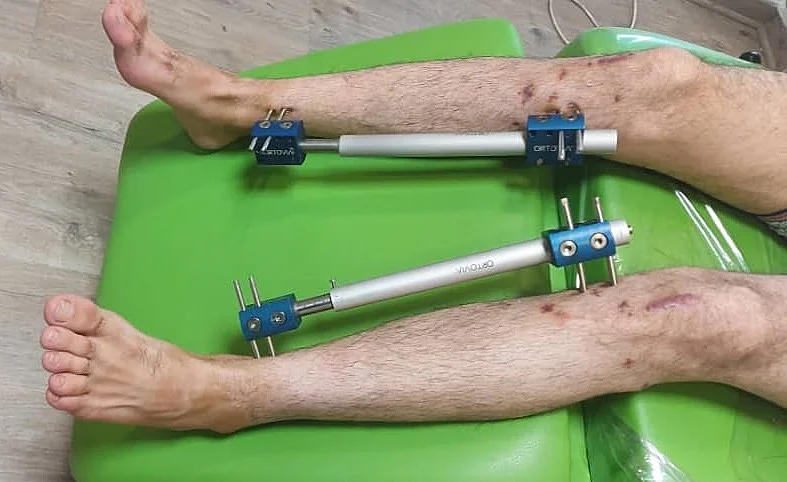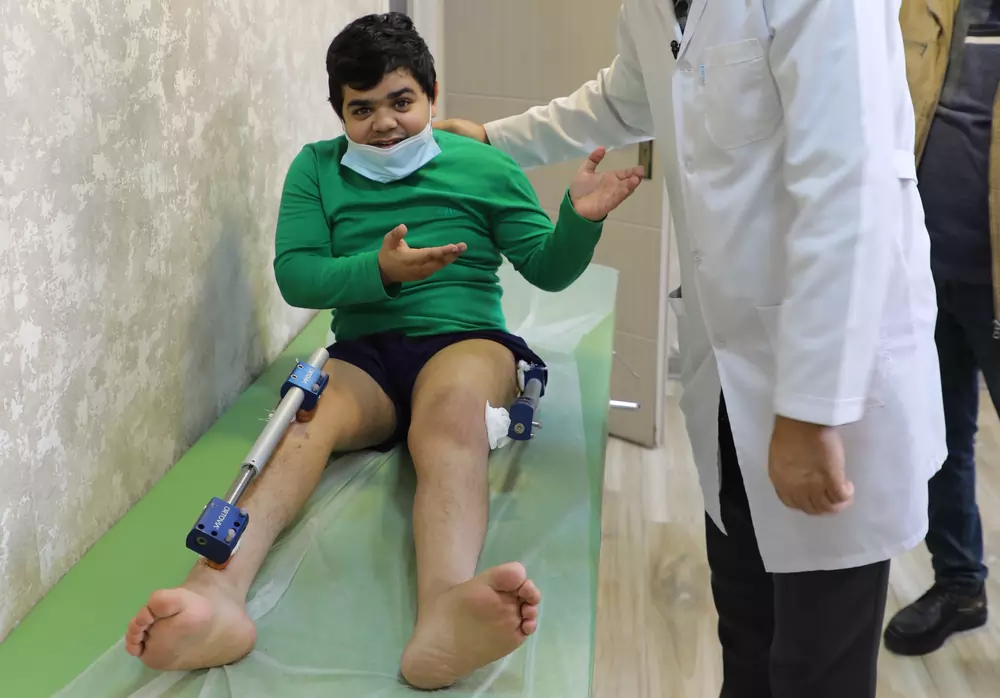Limb lengthening surgery side effects
Just like any surgical procedure, limb lengthening surgery may cause some problems. This article explored the potential risks, complications, and side effects of leg lengthening surgery.

Limb lengthening surgery starts with an osteotomy, in which an orthopedic surgeon cuts the lengthening bone. The surgeon then secures the bone with external fixators and internal nails. The cut bones are opened daily at regular intervals when surgery is done. Consequently, the body renews bone, filling the gap with new bone tissue.
Limb lengthening is a surgical procedure performed on the main leg bones that support the body. As a result, it carries several risks and necessitates special care and attention throughout treatment.
Limb lengthening surgery side effects
The following are some of the side effects of limb lengthening surgery:
- Bone healing can indeed be slow or fast.
- Contractures of the muscles
- Osteomyelitis (bone infection)
- Nerve and blood vessel damage
- contractures and stiffness of the joints.
- Pin site infection
- Sleeping difficulties and pain
Now, we will discuss the details of the above complications, side effects, and risks.
- Bone healing can indeed be slow or fast.
Procedures to extend limbs involve the growth and repair of new bone. The bone may occasionally heal either too quickly or too slowly. The medical staff frequently X-rays patients and tracks their development to find similar issues early on.
In the case of fast bone healing, some people recover their bones more quickly. This condition is a result of that person’s unique biological reaction. It is not brought on by carelessness or improper execution of the process.
The doctor may increase the daily lengthening amount to stabilize the procedure if fast bone healing is shown during the lengthening phase. If the quick bone healing is to blame for the bone union, a second surgical surgery might be needed to repair it.
In the case of slow bone healing, some patients’ new bones do not develop as soon as they should. This is one of the issues that, with intervention, can be resolved and is detectable by x-ray during the lengthening phase. The doctor decides to scale back the daily extension in such circumstances. So, the course of treatment can last longer than anticipated.
The union of the bones can fail in various instances. Nonunion is the term used to describe the situation where the bone does not mend. In such circumstances, the surgeon may stop, reverse, or choose a different surgical treatment. But nonunion is incredibly infrequent.
- Contractures of the muscles
Muscle adaptation must maintain pace with bone extension during leg lengthening. Otherwise, a mismatch in bone and muscle length will severely impact the leg’s mobility and the operation’s success. Patients should engage in frequent exercise and physiotherapy sessions to prevent this consequence, which also hurts.
- Osteomyelitis (bone infection)
For various reasons, osteomyelitis, commonly referred to as bone infection, is one of the problems that might develop after limb-lengthening surgery.
A bone infection can develop through diffusion into the bloodstream or surrounding soft tissue due to an open wound or other immune-system-affecting factor. Osteomyelitis is more prevalent with lengthening techniques that call for external fixation and routine dressing. Patients who have had lengthening surgery combined with internal operations can also experience it.
Early osteomyelitis risk detection involves a physical examination, blood tests, imaging examinations, and occasionally a bone sample. With routine pin site treatment in the external and LON limb lengthening methods, this complication can be avoided, and the risk is generally reduced.
In the event of osteomyelitis, the medical staff and doctor will attentively monitor the patient. The patient can be treated early in the problemwith antibiotics and analgesics. However, surgery may be required to treat osteomyelitis in a few rare instances.
- Nerve and blood vessel damage
The fixator used by the surgeon in the external and combination methods employs wires and needles to affix itself to the bone while blocking the nerves and blood arteries. However, there is a minimal chance that the operation will harm a nerve or blood vessel.
Injury to the nerves might result in a temporary or permanent loss of movement or feeling. The patient could require additional surgery in these situations if recovery is sluggish.
Depending on the severity of the damage, blood loss can happen with blood vessel injuries. But if a sizable blood vessel is injured, surgery might be required to fix it.
- contractures and stiffness of the joints.
The muscles that expand with the bone during a limb lengthening surgery may become tense, stiff, and sore during the lengthening phase. This scenario may impact joint mobility. A joint may stiffen or even start to dislocate if a muscle gets too tight and starts pulling on the nearby joints.
In such circumstances, the surgeon may reduce or discontinue the action to regain joint motion. Rarely, the patient may require surgical treatment.
Frequent exercise and physiotherapy sessions are also essential to prevent and treat joint stiffness and contractures.
- Pin site infection
External fixation methods for limb lengthening, like LON or LATN methods, can result in pin-site infections. Insufficient dressing changes and poor needle care techniques are the primary causes of pin site infections.

The medical staff regularly monitors infection in such situations. Antibiotic medications are typically effective in treating this problem. However, because it can produce new scar tissue or osteomyelitis, it is also a severe consequence.
- Sleeping difficulties and pain
Every patient will suffer pain throughout limb lengthening treatments at some point, from the first day following surgery to full recovery. Even though the pain is severe in the initial days following surgery, it becomes manageable within a week thanks to applying a treatment regimen that comprises the medications to be used by the degree of the pain.
Everybody experiences pain to varying degrees and ways. Pain and pain thresholds are, therefore, highly subjective. Some patients are more pain-resistant than others, and vice versa.
Additionally, some patients may have trouble sleeping the first few nights after surgery because of pain. While you are receiving treatment, the medical staff and the surgeon take your problems seriously and make sure they are resolved by using the appropriate treatment methods.
Recommended Article: Is limb lengthening surgery worth it?
How can potential dangers, side effects, and complications be avoided?
The first step to prevent potential dangers, side effects, and consequences from your operation is to select physicians specializing in these limb lengthening and deformity repair techniques.
The surgeon and medical staff explain the lengthening and treatment process to patients before and after limb-lengthening surgery. To reduce risks and potential consequences, patients must thoroughly understand the procedure, heed the doctor’s advice, and follow the prescribed course of action.
In addition to the problems listed above, there is always a chance of running into more issues. Because of this, you must adhere to the doctor’s recommendations during your therapy, get x-rays regularly, and be completely honest with the medical staff about your health.
In his 21 years of experience, Dr. Nader Motallebizadeh has done more than 500 successful limb-lengthening procedures, making him the most skilled orthopedic surgeon in Iran. Additionally, we have a professional medical staff that will guard against any adverse effects you might encounter while receiving therapy and tell you about them.
FAQ
Is Limb lengthening surgery has side effects?
Just like any surgical procedure, limb lengthening surgery may cause some problems. The following are some of the side effects of limb lengthening surgery: Bone healing can indeed be slow or fast.
Contractures of the muscles
Osteomyelitis (bone infection)
Nerve and blood vessel damage
contractures and stiffness of the joints.
Pin site infection
Sleeping difficulties and pain
How can potential dangers, side effects, and complications be avoided?
The first step you should take to prevent potential dangers, side effects, and consequences from your operation is to select physicians who specialize in these limb lengthening and deformity repair techniques. To reduce risks and potential consequences, patients must completely understand the procedure, heed the doctor’s advice, and carefully follow the prescribed course of action.
What happens if the bone is lengthened too slowly?
Even though the usual lengthening rate is 1 mm per day, each person responds differently to bone lengthening. The bones of some people are very quickly healed and maybe hardened before the completion of treatment. This is the case of premature consolidation. Two other bone groups cannot be separated when the reconstructed bone hardens. The bone may recover before reaching the desired length. The doctor often sees the patient during distraction to prevent premature consolidation.
When during the follow-up visit, premature consolidation in X-rays is seen, one of the options is selectable and performable; for example, the increase rate may increase from 1 mm per day to 1.5 mm or even 2 mm per day. If the reconstructed bone is fully strengthened, it may be necessary to cut the bone again with surgery to continue the lengthening can continue. This requires a return to the operating room, usually as an outpatient procedure, which means the patient does not need to stay in the hospital.
What happens if the bone is lengthened too quickly?
Even though the usual lengthening rate is 1 mm daily, some people’s bones need more time to heal and may require more bone formation time. For example, healing may be slower in smokers and diabetics.
The regenerated bone should be formed to act as a bridge between two separate bone sections. The doctor will want to see the patient every 7 to 14 days during distraction to ensure the bones, muscles, and nerves are well-responsive to lengthening.
In cases where the bone is weak, the orthopedic device can be adjusted for temporary bone shortening until the reconstructed bone is improved. After starting the reconstruction between bone sections, the doctor allows the patient to lengthen the bone.
Another issue that can occur during limb lengthening is that soft tissues (muscles, nerves, ligaments, tendons) may resist stretching during the lengthening process, which can cause them to stiffen. . A non-surgical option for treating stiff muscles is to increase the amount of stretching during physiotherapy sessions. During the distraction, the patient should receive physiotherapy twice a week.



